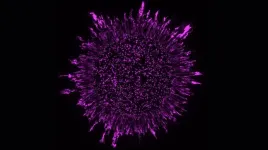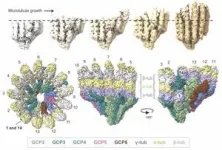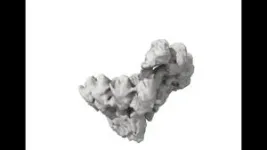(Press-News.org) Bacteria are traditionally imagined as single-cell organisms, spread out sparsely over surfaces or suspended in liquids, but in many environments the true bacterial mode of growth is in sticky clusters called biofilms. Biofilm formation can be useful to humans—it is integral, for example, to the production of kombucha tea. But it is more often problematic, because it makes it more difficult to control bacterial growth: When bacterial cells produce a biofilm, it acts as a shield against outside invaders, making the bacteria more tolerant to antibiotics.
Until recently, researchers had assumed that bacteria were arranged somewhat randomly in biofilms, insofar as they had thought about the question of biofilm structure at all. But new research from Columbia University biology professor Lars Dietrich’s lab shows that bacteria that form biofilms actually have a highly structured arrangement within those slimy matrices.
Their unexpected finding could pave the way for developing new drugs that better target antibiotic-resistant bacteria.
“There’s a yin-yang trade-off for bacteria that form biofilms, since the biofilm guards against antibiotics and other threats, but also prevents food from entering and feeding the system,” said Professor Lars Dietrich, a lead author on the paper. “This research gives us an important foundation for understanding how to affect bacterial-cell arrangement and assess how to make them more susceptible to antibiotics.”
The new study, published in the journal PLOS Biology, details research conducted in professor Dietrich’s lab, spearheaded by graduate student Hannah Dayton. The paper looked specifically at an important, common pathogen, called Pseudomonas aeruginosa.
The team used scanning electron microscopy and fluorescence microscopy paired with cell labeling to conduct their research. They found that P. aeruginosa cells in biofilms are packed lengthwise and arranged perpendicularly to their growth substrate, the material that the bacteria live on and that contains the substance they are eating to survive and grow. They also found that mutations that modify the bacterial cell surface disrupt this arrangement.
When they tested the effects of a sugar added from the outside to a fully formed biofilm, they observed that its distribution was affected by the biofilm anatomy. Mutant bacteria with a disordered cellular arrangement were more responsive to added sugar or antibiotic in specific areas within the biofilm, also known as subzones. Finally, they showed that changes in biofilm anatomy shift the location of peak metabolic activity within the structure.
Together, these observations indicate that biofilm microstructure is a property that can be tuned to influence the metabolism of resident bacterial subpopulations and affect the overall survival of the group. The findings have implications for our approaches to treating infections caused by P. aeruginosa and other biofilm-forming pathogens.
The research was conducted in collaboration with the research groups of Wei Min, a Columbia chemistry professor; Raju Tomer, a Columbia biology professor; Jasmine Nirody, professor at the University of Chicago; and Anuradha Janakiraman, professor at the City University of New York (CUNY).
“The arrangement of cells is generally an underappreciated aspect of biofilm formation,” said Dayton. “We now know that it allows bacteria in biofilms to control their physiological states and has consequences for their survival during antibiotic treatment.”
“This is a promising development for the pernicious and growing problem of antibiotic resistant bacteria,” said Dietrich.
END
New research shows that the arrangement of bacteria in biofilms affects their sensitivity to antibiotics
2024-02-01
ELSE PRESS RELEASES FROM THIS DATE:
First atomic-scale 'movie' of microtubules under construction, a key process for cell division
2024-02-01
· Researchers at the Centre for Genomic Regulation (CRG) , the Spanish National Cancer Research Center (CNIO) and the IBMB-CSIC solve a key problem in biology: how human cells build their microtubules
· During cell division, microtubules function as nanometer-thick long ‘ropes' inside cells that pull chromosomes apart so that each daughter cell receives a copy of the genetic material
· The work published in Science lays the groundwork for future breakthroughs in the treatment of diseases ranging from cancer to neurodevelopmental disorders
Cells in the human body are constantly dividing. With each division the genetic information contained in the ...
Mapping the structure and organization of hippocampal neurons in the mouse brain
2024-02-01
Single-cell projectome analysis has revealed previously unknown spatial organization principles of the brain-wide structure and connectivity of more than 10,000 individual hippocampal neurons in the mouse brain, according to a new study. Specialized projections called axons allow neurons to transmit signals to other neurons across the brain. The hippocampus (HIP) – one of the most extensively studied brain regions – plays a crucial role in many crucial brain functions, including learning, memory, ...
Large herbivores’ effects on ecosystems depend more on size and diet than on herbivore origin
2024-02-01
The effect of large herbivores on plant abundance and diversity depends more on their size and diet than whether they are native or introduced into their host ecosystems, according to a meta-analysis of more than 200 studies worldwide. The findings counter the widely held notion that the impacts of introduced megafauna are distinct and more harmful than those of native megafauna and suggest that trait-based ecology provides better insight into megaherbivore-plant interactions than concepts of species origin. Large mammal herbivores play a key role in shaping ecosystems and biodiversity by consuming vegetation, dispersing seeds and nutrients, and creating ...
The evolution of sign languages globally revealed through computational analyses
2024-02-01
A computational analysis has highlighted the poorly understood relationships and elusive histories of modern sign languages worldwide, revealing two major sign language families shaped by geopolitical forces and relevant signing communities. The findings show that the computational methods applied – which have been useful in understanding spoken languages – can be extended to the study of sign languages; as such, they offer promise for addressing the disparities in our understanding of other marginalized and diverse ...
AI system reveals new insights into early language acquisition through the experience of a single child
2024-02-01
A new machine learning model – trained on video and audio recorded from the first-person perspective of one young child for over a year – has provided new insights into early language acquisition. Not only do the findings offer a valuable framework to understand how children learn words and concepts, but they could be critical in developing artificial intelligence (AI) systems that can learn language in more human-like ways. Beginning around 6 to 9 months of age, children begin acquiring their ...
Targeting treatment resistance in chronic lymphocytic leukemia
2024-02-01
MIAMI, FLORIDA (EMBARGOED UNTIL FEB. 1, 2024, AT 2 P.M. ET) – New research from Sylvester Comprehensive Cancer Center at the University of Miami Miller School of Medicine and collaborating organizations has identified a next-generation BTK degrader that could help overcome treatment resistance in chronic lymphocytic leukemia (CLL) and related blood cancers.
Their findings, published Feb. 2 in the journal Science, could offer a therapeutic option for CLL patients whose tumors become drug-resistant or are unresponsive to frontline treatment.
“This new compound not only inhibits the cellular molecule BTK, but goes further by taking aim at the target ...
Sustainable carbon removals limits identified, huge climate mitigation challenge revealed
2024-02-01
*Embargoed until 14:00 US Eastern / 19:00 UK GMT / 20:00 Europe CET – Thursday 1 February*
Governments and businesses are relying on dangerous amounts of future removal of carbon dioxide (CO2) from the atmosphere, instead of more rapidly reducing emissions and phasing out fossil fuels. This problem is partly due to an incomplete picture1 of the damaging consequences of carbon dioxide removal for people, food security and natural ecosystems, according to new research published in Science.
The paper finds that the carbon dioxide removal potential currently reported by the UN ...
Whole-brain projection patterns of single neurons in mouse hippocampus unveiled
2024-02-01
A study published in Science on Feb. 1 reported a comprehensive database of single-neuron projectomes consisting of over 10,000 mouse hippocampal neurons, thus revealing the spatial connectivity patterns of mouse hippocampal neurons at the mesoscopic level.
The study was conducted by teams from the Center for Excellence in Brain Science and Intelligence Technology (CEBSIT), the Institute of Neuroscience of the Chinese Academy of Sciences (CAS), the HUST-Suzhou Institute for Brainsmatics, Hainan University, the Kunming Institute of Zoology of CAS, Lingang Laboratory, and the Shanghai Center for ...
New study suggests culling animals who ‘don’t belong’ can be a flawed nature conservation practice
2024-02-01
New research published today in the journal Science has concluded that eradicating animals on the basis that they are not native in order to protect plant species, can be a flawed practice costing millions of dollars, and resulting in the slaughter of millions of healthy wild animals.
Introduced large herbivores, or megafauna, are claimed to have distinct and harmful ecological impacts, including damaging sensitive plants and habitats, reducing native plant diversity, and facilitating introduced plants. However, up to now these impacts have been studied without comparison to a proper ...
IU surgeon-scientist studying physiological effect of microorganisms in sinuses of chronic rhinosinusitis patients
2024-02-01
INDIANAPOLIS—An Indiana University School of Medicine surgeon-scientist is leading a multi-institutional grant investigating the role of the sinus microbiome in chronic rhinosinusitis, an inflammatory disease that causes the lining of the sinuses to swell. The research team will study biospecimens from human sinus surgery patients in the lab and examine how bacteria in the microbiome shape the disease process and might offer novel therapeutic strategies.
Vijay Ramakrishnan, MD, professor of otolaryngology—head ...





